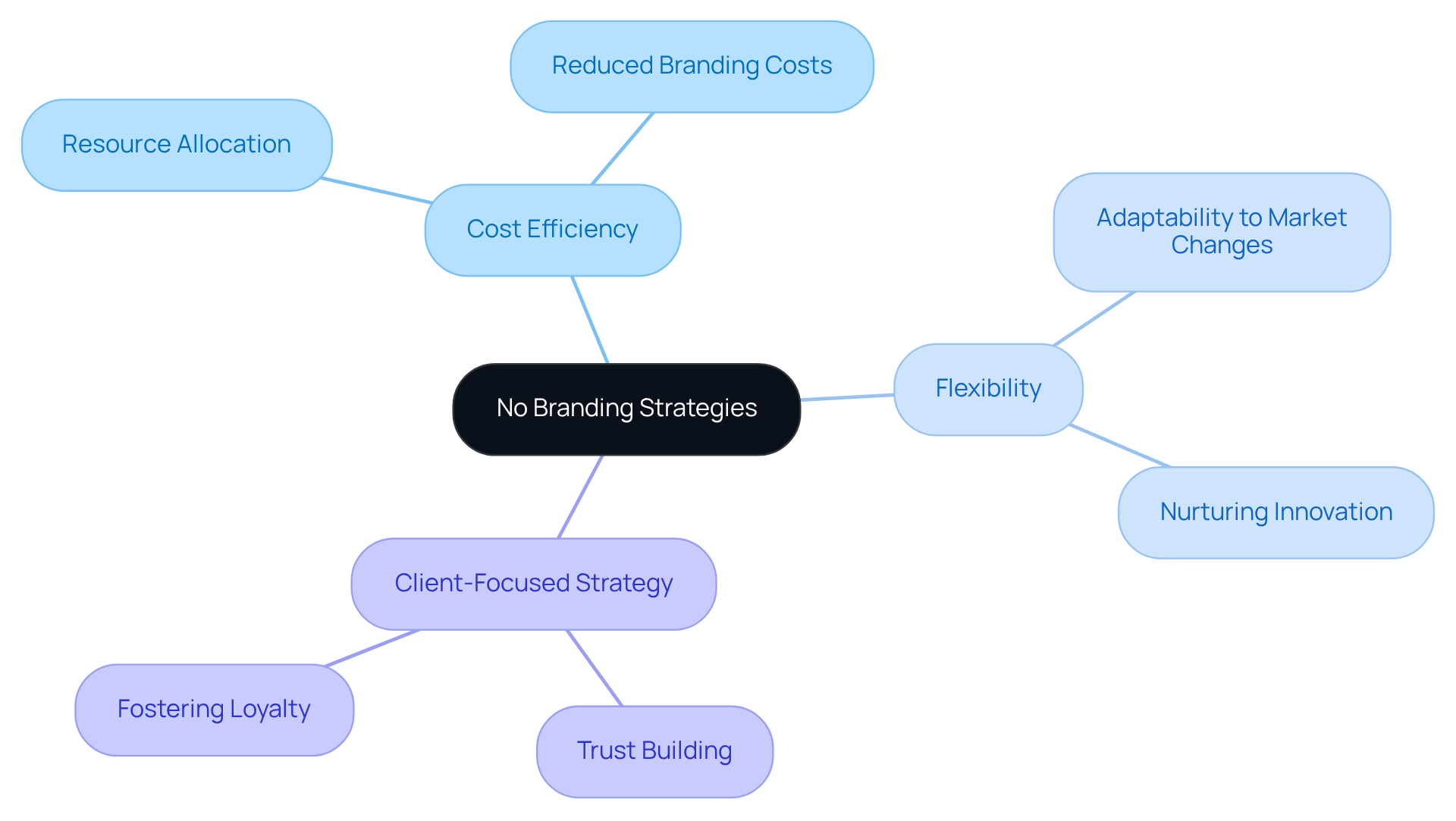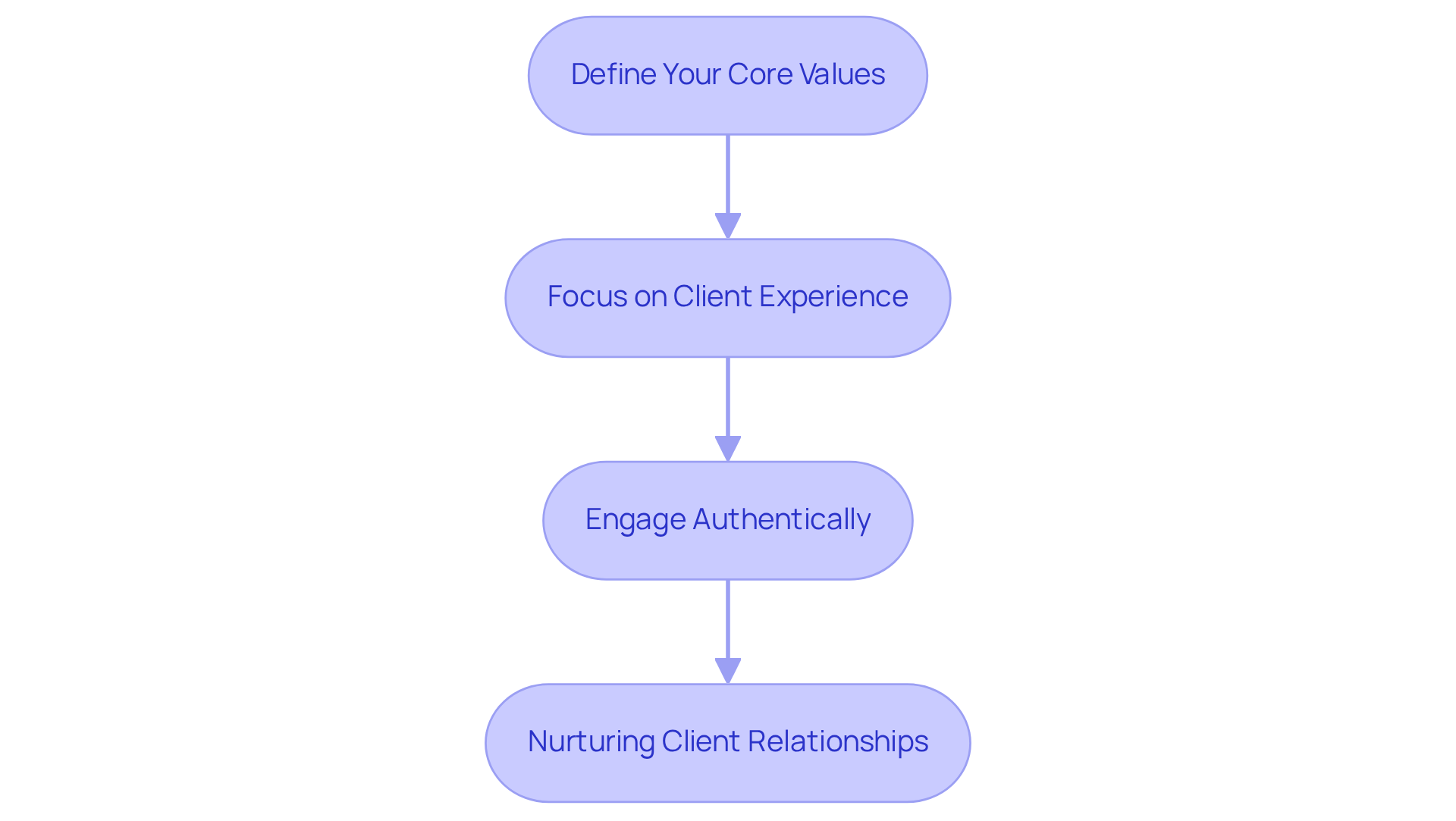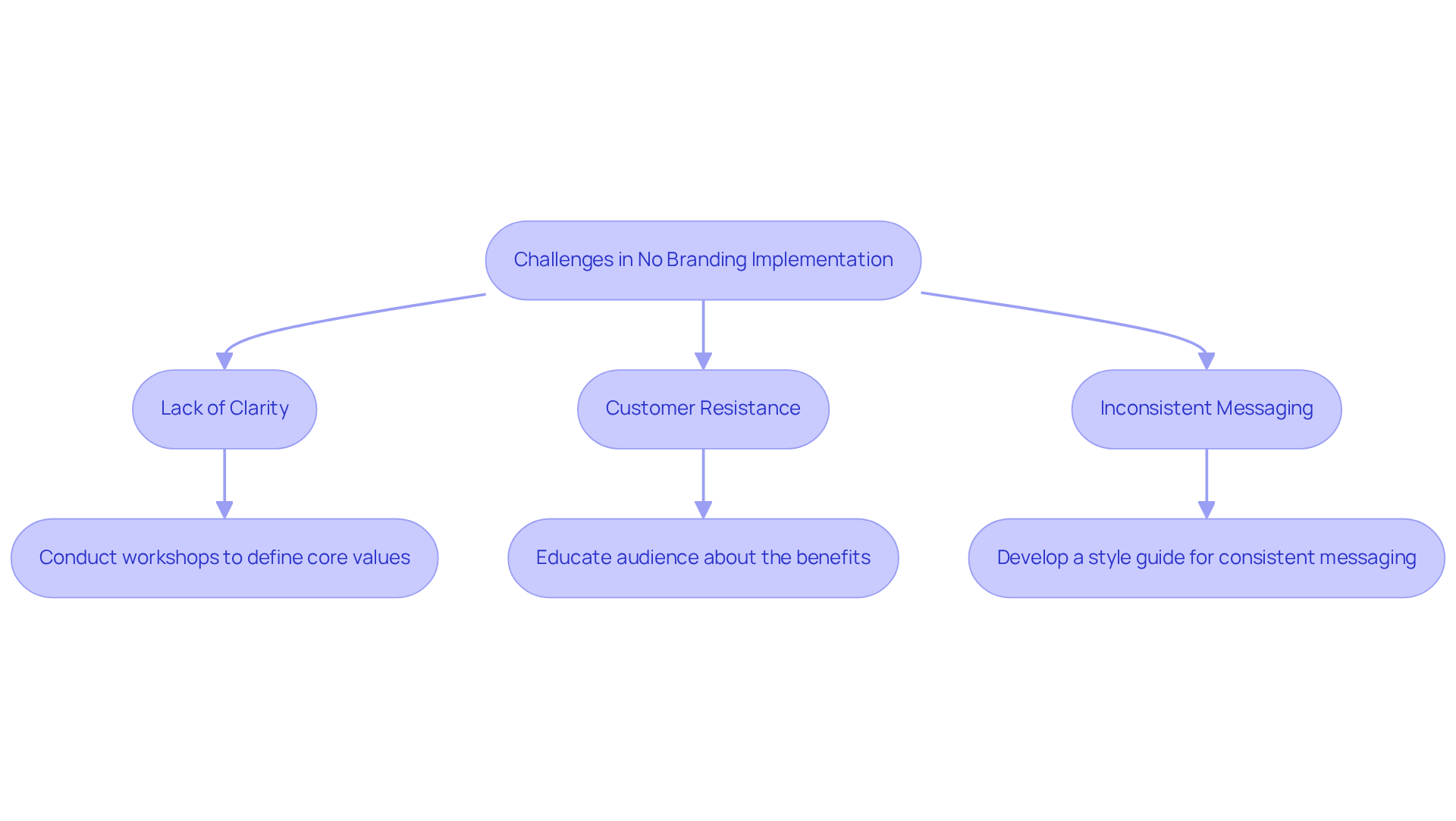Overview
In the journey of launching a startup, many founders grapple with the challenge of establishing a brand that resonates deeply with their audience. This struggle can often lead to feelings of isolation and uncertainty, as the pressure to stand out in a crowded market weighs heavily. However, there is hope. By implementing no branding strategies, startups can redefine their approach and foster genuine connections with their clients.
The first step is to define your core values. This is not just a checklist; it's about understanding what truly drives your mission and how you want to impact your community. When your values are clear, they serve as a guiding light, helping you navigate the complexities of the market while staying true to your purpose.
Next, focus on the client experience. Every interaction with your audience is an opportunity to build trust and loyalty. By prioritizing their needs and feedback, you create a space where clients feel valued and heard, turning them into advocates for your brand.
Finally, engage authentically with your audience. Share your journey, your struggles, and your successes. This openness not only humanizes your brand but also invites your audience to join you on this adventure. Remember, you are not alone in this; many founders share similar experiences and challenges. By fostering a supportive community, you can create a network that uplifts and inspires.
These steps are not just strategies; they are pathways to sustainable growth and a thriving community around your business. Embrace this journey with compassion and understanding, and watch as your startup flourishes.
Introduction
In a marketplace flooded with logos and slogans, the idea of no branding might seem counterintuitive. Yet, for startups yearning for genuine connections with their audience, it offers a refreshing alternative. By placing authenticity and user experience above traditional branding, businesses can cultivate trust, loyalty, and flexibility—qualities that are essential for thriving in today’s competitive landscape.
However, many founders may wonder: how can they effectively navigate the challenges of implementing such unconventional strategies while ensuring they truly resonate with their target market? This is a common concern, and it’s important to explore how embracing a no-branding approach can lead to meaningful engagement and lasting relationships.
Understand No Branding Strategies and Their Benefits
In the competitive world of startups, many founders grapple with the challenge of conventional marketing techniques that often prioritize logos and taglines over genuine connections with clients. This traditional approach can feel impersonal and may leave you wondering how to truly engage your audience. The pain point here is clear: in a landscape where authenticity is key, having no branding can hinder your ability to foster meaningful relationships.
Instead, consider embracing strategies that prioritize authenticity, transparency, and an outstanding user experience. By doing so, you can unlock several significant benefits. For instance, cost efficiency becomes a major advantage; with no branding costs to burden you, you can allocate resources to essential areas like product development and marketing, ensuring your startup thrives.
Moreover, flexibility is another crucial benefit. By avoiding a rigid brand identity, you empower your business to adapt swiftly to market changes and client feedback, nurturing a culture of innovation that can set you apart. This adaptability is vital as it allows you to respond to your audience's needs more effectively.
Lastly, adopting a client-focused strategy fosters trust and loyalty. By prioritizing user experience with no branding, you can build lasting connections with your audience, creating a supportive community around your startup.
Understanding these advantages is essential for startups eager to stand out in a competitive landscape. As industry experts emphasize, authenticity and transparency are not just buzzwords; they are the foundation of a brand that resonates with consumers. When you cultivate these qualities, you and satisfaction, creating a nurturing environment for your business to flourish. Remember, your journey as a startup founder is unique, and by focusing on these principles, you're not just building a brand; you're creating a meaningful connection with your clients.

Implement Step-by-Step No Branding Strategies
To effectively implement , it's essential to navigate through some common challenges. Many startup founders struggle with establishing a strong connection with their audience. This can lead to feelings of uncertainty and frustration, as the lack of a clear identity often results in missed opportunities for engagement and loyalty. However, by following these nurturing steps, you can cultivate authentic relationships with your clients.
-
Define Your Core Values: Start by identifying the fundamental principles that drive your startup. These values should resonate deeply with your target audience and act as a guiding light for your business decisions.
- Actionable Tip: Consider conducting surveys or focus groups to gather insights on what values matter most to your clients. This not only aligns your mission with client expectations but also fosters loyalty. After all, 89% of employees express positive sentiments about employers who uphold strong cultures.
-
Focus on Client Experience: Create a seamless and enjoyable experience for your clients at every touchpoint—whether it's your website, support service, or product interactions.
- Actionable Tip: Take a moment to outline the client journey and pinpoint areas for enhancement to increase satisfaction. Statistics reveal that 57% of clients won’t endorse a business with a poorly designed mobile website. Remember, 1 in 3 clients may abandon a cherished brand after just one negative experience, highlighting the importance of maintaining high standards.
-
Engage Authentically: Use social media and other platforms to communicate directly with your audience. Share stories, insights, and behind-the-scenes content that reflect your company's values.
- Actionable Tip: Develop a content calendar that outlines what and when to post, ensuring consistent engagement with your audience. Proactive communication is key, as over 85% of clients wish to engage with businesses that anticipate their needs and address potential issues before they arise.
By adhering to these thoughtful actions, new businesses can efficiently apply strategies with no branding that nurture genuine relationships with their clients. This nurturing strategy ultimately boosts loyalty and promotes sustainable growth.

Troubleshoot Common Challenges in No Branding Implementation
While executing strategies with no branding can be advantageous, new businesses may face several challenges that can feel overwhelming. Let’s explore some common issues and how to approach them with care:
-
Lack of Clarity: Startups often struggle to define their core values or customer experience goals, which can lead to confusion and misalignment.
- Solution: Consider conducting workshops with your team to brainstorm and clarify your startup's mission and values. This collaborative effort not only fosters alignment but also nurtures a .
-
Customer Resistance: Some clients may prefer conventional marketing and might not respond positively to a no branding approach, creating a barrier to engagement.
- Solution: It’s essential to educate your audience about the benefits of your approach through informative content and transparent communication. As Warren Buffett wisely noted, 'It takes 20 years to establish a reputation and five minutes to destroy it,' reminding us of the importance of building trust in our methods.
-
Inconsistent Messaging: Without a defined brand identity, messaging can become inconsistent, leaving potential customers unsure of what to expect.
- Solution: Developing a style guide that outlines your tone, language, and messaging principles can help maintain consistency across all platforms. This clarity will foster trust and enhance the connection with your audience.
By integrating these approaches, startups can successfully navigate the challenges of no branding methods, nurturing stronger relationships with their audience and boosting overall engagement. Additionally, consider the inspiring case study of RNO1's collaboration with Cirkul, which illustrates how tailored strategies can significantly enhance customer engagement and address resistance to new approaches. Let’s embrace this journey together, knowing that every step taken is a step towards building a supportive community.

Conclusion
Embracing no branding strategies can truly transform how startups connect with their clients, placing authenticity and user experience at the forefront instead of relying on traditional marketing methods. By stepping away from conventional branding, startups have the opportunity to build deeper connections with their audience, which can lead to increased trust and loyalty. This approach not only eases the financial strain associated with branding but also offers greater flexibility and responsiveness to the ever-changing market demands.
The article presents a clear and supportive path for effectively implementing these strategies. Startups are encouraged to:
- Define their core values
- Enhance client experiences
- Engage authentically with their audience
Each step is thoughtfully designed to cultivate genuine relationships, addressing common challenges such as:
- Lack of clarity
- Customer resistance
- Inconsistent messaging
By embracing these insights, new businesses can navigate the complexities of no branding with confidence and purpose.
Ultimately, the shift towards no branding strategies represents a significant opportunity for startups to stand out in a crowded marketplace. It’s important to remember that this journey involves continuous learning and adaptation. By committing to these principles, startups not only lay a strong foundation for growth but also foster a supportive community around their mission. Embrace this challenge, and let authenticity guide you towards sustainable success.
Frequently Asked Questions
What are no branding strategies?
No branding strategies prioritize authenticity, transparency, and user experience over conventional marketing techniques that focus on logos and taglines.
What are the benefits of adopting no branding strategies?
The benefits include cost efficiency, flexibility to adapt to market changes, and fostering trust and loyalty among clients.
How does cost efficiency play a role in no branding strategies?
Without the burden of branding costs, resources can be allocated to essential areas like product development and marketing, helping the startup thrive.
Why is flexibility important in no branding strategies?
Flexibility allows businesses to adapt swiftly to market changes and client feedback, nurturing a culture of innovation that can differentiate them from competitors.
How do no branding strategies foster trust and loyalty?
By focusing on user experience and building genuine connections, startups can create a supportive community and lasting relationships with their audience.
What qualities are essential for a brand that resonates with consumers?
Authenticity and transparency are essential qualities that enhance customer loyalty and satisfaction, contributing to a nurturing environment for business growth.




